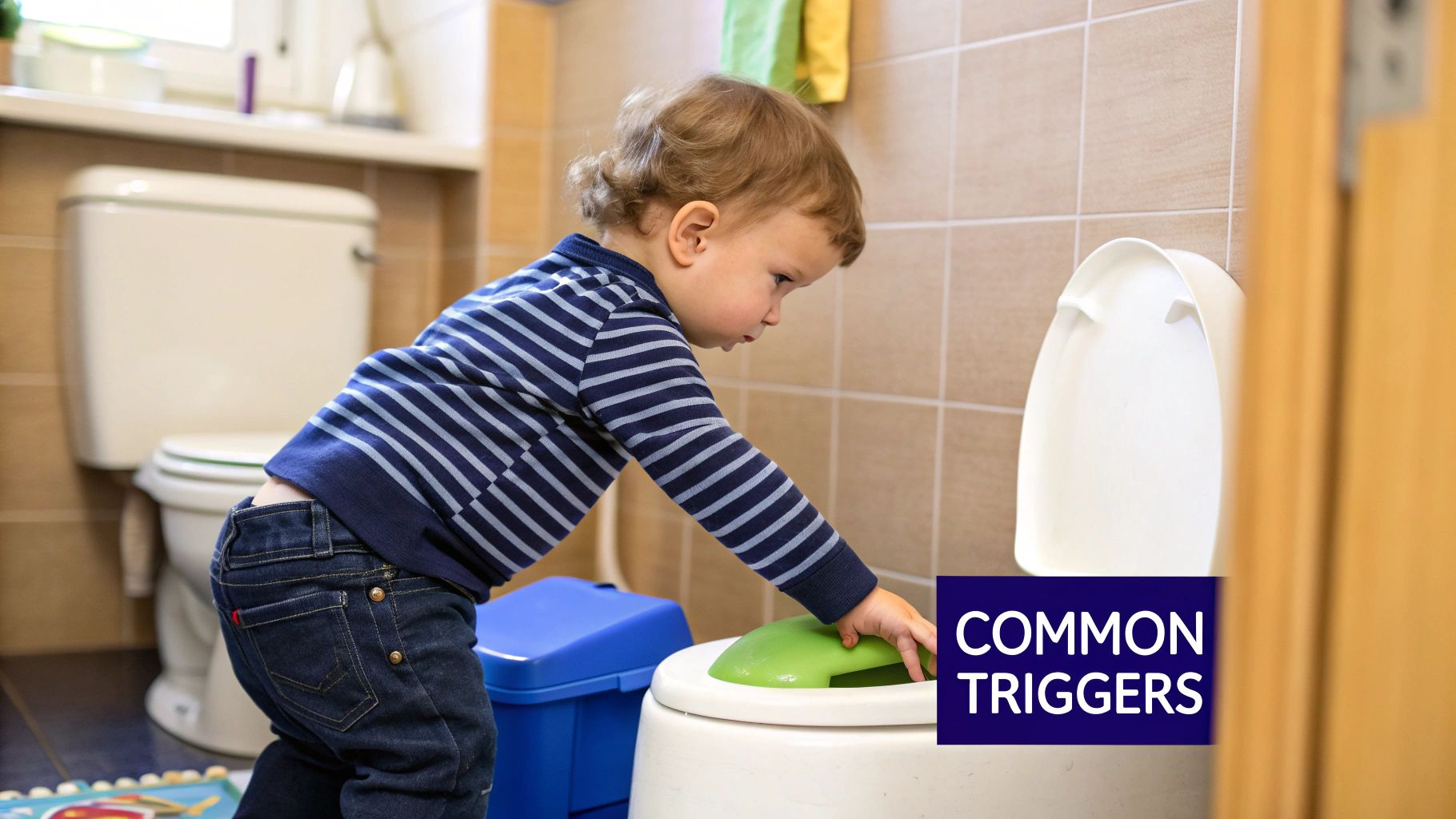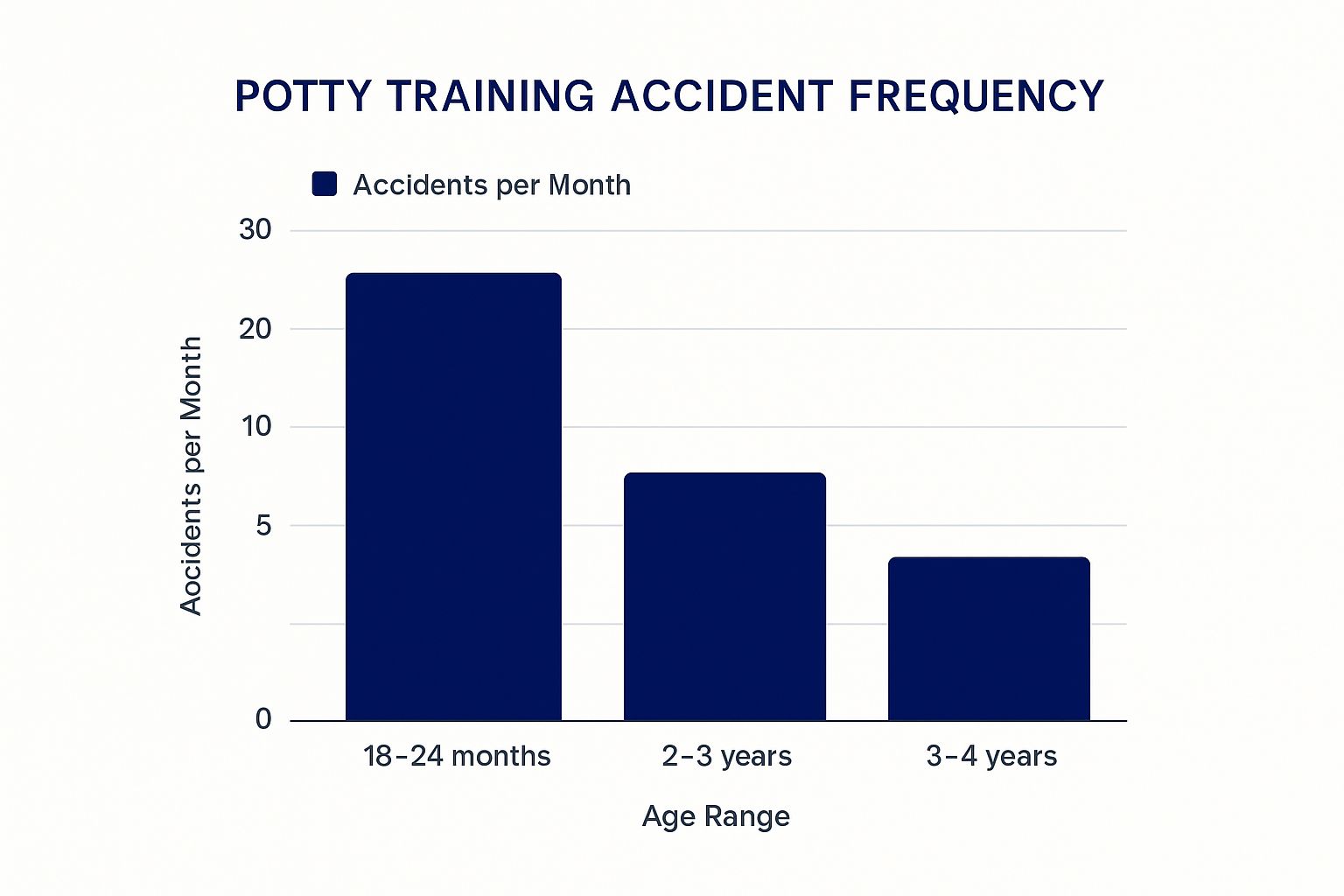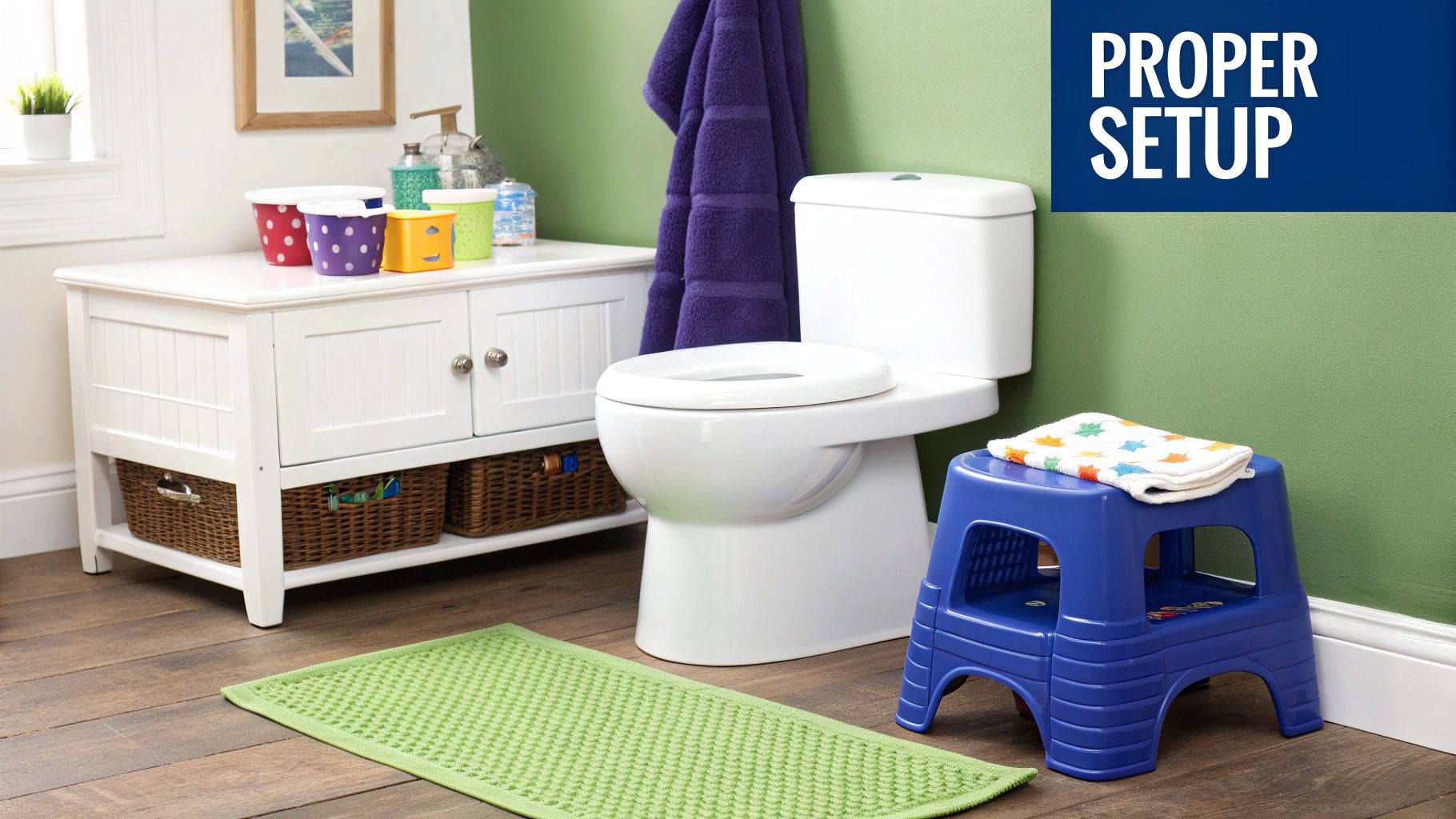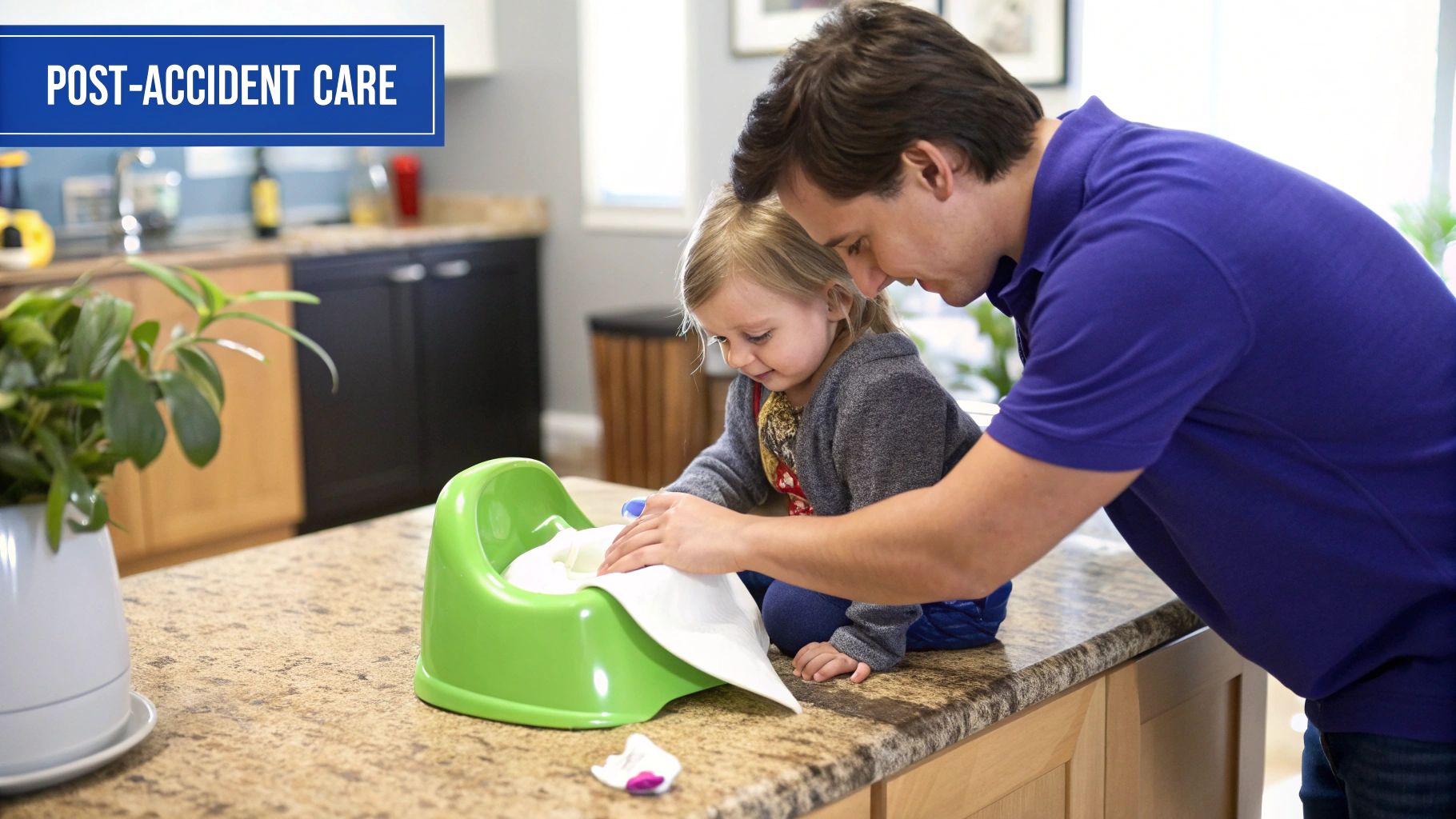What Parents Wish They'd Known About Accidents

Let’s get real for a moment: the perfect potty training experience you see in your head rarely plays out that way. The initial thrill of saying goodbye to diapers often fades into a reality of constant outfit changes and frantic carpet cleaning. If you're feeling swamped by potty training accidents, you're definitely not the only one. This is the messy, often unspoken, part of the journey.
It’s so important to have realistic expectations from the start. Some kids seem to get it in a flash, while others take a much longer, winding path. This difference has nothing to do with your parenting or how smart your child is; it's just a normal part of their development. Things like your child's personality—whether they're a cautious planner or a dive-right-in type—and where they are developmentally play a huge role in how many accidents they have. Knowing this can help you trade frustration for patience.
The Reality of Early Potty Training
One of the biggest surprises for parents is just how many accidents are normal, especially at the very beginning. It doesn't mean you're failing; it means your child is actively learning. They're figuring out a pretty complex new skill that involves recognizing body signals and then getting their muscles to cooperate.
Research backs this up. A UK survey of over 1,200 parents showed just how common this is. On the very first day without diapers, 31% of kids had three to four accidents. Another 12% had five to seven, and a busy 5% of parents dealt with more than eight accidents in a single day. These numbers show that a day full of cleanups is a standard rite of passage.
Normal Learning vs. Potential Red Flags
So, how can you tell the difference between typical learning hiccups and something that might need a little more attention?
- Normal Accidents: These are the "oops" moments that happen when your child is completely absorbed in playing, is super tired, or gets overly excited. They just forget to tune into their body's signals until it's too late. These types of accidents should slowly become less frequent.
- Potential Red Flags: If your child consistently refuses to even try the potty, shows signs of pain when they go, or suddenly starts having way more accidents after being successful for a while (this is called regression), it might be worth investigating further.
The emotional side for parents is a big deal, too. It’s a mix of excitement, frustration, and worry. One minute you're cheering for a potty success, the next you're on your hands and knees with a rag. Accepting this emotional rollercoaster is the key to staying calm. Progress isn't always a straight line; there will be great days and not-so-great days, and that's completely okay. For a complete look at the whole process, you might find our ultimate potty training guide helpful.
Setting Up Your Home for Inevitable Spills
Smart preparation is your secret weapon for managing potty training accidents calmly and effectively. Creating a home environment that minimizes stress and makes cleanup a breeze can be the difference between a minor hiccup and a major meltdown. I like to think of it as creating "potty training zones," especially in high-traffic areas like the living room and your child's playroom.
A popular and effective tactic is to temporarily roll up any cherished area rugs. If that’s just not practical for your space, a high-quality, non-slip waterproof rug pad is a fantastic investment. It’s a small change that offers huge peace of mind by protecting your floors. The same idea applies to your furniture. For the first few weeks, drape your couches and chairs with machine-washable throws or dedicated waterproof furniture protectors. This makes spills feel like no big deal.
This chart gives a helpful overview of how often accidents typically happen at different ages, so you can set realistic expectations.

As you can see, accidents are a normal part of the learning curve, decreasing as your child gets older and gains more control.
To help you choose the right supplies for your home, we've put together a comparison table of essential accident-proofing gear.
Essential Accident-Proofing Supplies Comparison
Compare different types of floor protection, cleaning supplies, and safety equipment with effectiveness ratings and cost considerations.
| Product Type | Effectiveness Rating | Average Cost | Best Use Case | Parent Rating |
|---|---|---|---|---|
| Waterproof Rug Pad | ★★★★☆ | $30 - $80 | Protecting nice area rugs you can't remove. | ★★★★☆ |
| Machine-Washable Throws | ★★★☆☆ | $20 - $50 | Covering couches and chairs; easy to swap out. | ★★★★★ |
| Dedicated Furniture Protector | ★★★★★ | $25 - $60 | Maximum liquid protection for sofas and armchairs. | ★★★★☆ |
| Enzymatic Cleaner | ★★★★★ | $10 - $25 | Neutralizing urine odors on carpets and fabric. | ★★★★★ |
| Non-Slip Bath Mat | ★★★★★ | $15 - $30 | Preventing slips on wet bathroom floors. | ★★★★★ |
This table shows that while a simple washable throw is convenient, a dedicated furniture protector or rug pad offers superior defense. For cleanup, an enzymatic cleaner is a must-have for truly eliminating odors, not just covering them up.
Strategic Supply Stations
Instead of scrambling for supplies when an accident happens, set up a few small, well-stocked cleanup kits. I keep one caddy in our living room and another one upstairs. Each one has everything I need to handle a mess quickly:
- Paper towels or a stack of reusable cloths
- A bottle of enzymatic cleaner (this is essential for breaking down urine enzymes and preventing lingering smells)
- A spare pair of underwear and pants
- A small wet bag or plastic bag for soiled clothes
Having these kits ready means you can manage any potty training accidents right away, without turning a small spill into a chaotic event. For more supportive ideas to help your little one, you might enjoy our free Benny Learns to Potty eBook, which is a great companion to our training watches.
Bathroom Safety Tweaks
Making the bathroom a safe and inviting space is just as crucial as having your cleanup strategy down. While puddles on the floor are a common issue, other hazards can be present. An analysis of emergency room data revealed that a surprising 99% of injuries related to toilet training happen right at home. The most common problems were falling toilet seats and kids slipping on wet floors, especially for toddlers between two and three years old.
You can easily prevent these by securing the main toilet lid with a slow-close seat and placing a non-slip mat in front of the toilet and another inside or just outside the tub.
Reading Your Child's Readiness Signals

When it comes to potty training, timing isn't everything, but it's pretty close. Kicking things off before your child is truly ready is a very common reason for frequent potty training accidents and a whole lot of frustration for both of you. While those readiness checklists you find online are a decent starting point, they often miss a huge piece of the puzzle: the difference between being physically able and being emotionally prepared for what can sometimes feel like a marathon.
You might see your toddler staying dry for two hours at a time or mastering the art of pulling their pants up and down. These are fantastic physical steps. However, the emotional side is what really sets the stage for a smooth process. This is all about their ability to manage the small frustrations and inevitable setbacks without getting discouraged. A child who can do all the physical things but isn't emotionally on board might get anxious after one accident, which can spiral into resistance and a power struggle you never intended to start.
Physical vs. Emotional Readiness
So, what does emotional readiness even look like in a toddler? It’s a bit more subtle than just checking boxes.
- Curiosity Over Compliance: Are they genuinely interested in the toilet? Maybe they follow you into the bathroom, ask what the potty is for, or want to flush it just for fun. This natural curiosity is a much better sign than them just sitting on the potty because you asked them to.
- A Desire for Independence: This often shows up in other parts of their life first. They might insist on putting on their own shoes (even if they're on the wrong feet) or trying to pour their own juice. This drive to be a "big kid" is a huge motivator for learning to use the potty.
- Understanding Cause and Effect: The moment your child connects the feeling of needing to go with the action of using the potty is a major breakthrough. If you start pushing before they make this connection, you'll likely find yourself doing all the work while they're just along for the ride.
The Timing Sweet Spot
The age you decide to start can have effects down the road. For example, a significant longitudinal study of 8,000 British children revealed that beginning potty training after 24 months was linked to a greater risk of bladder control issues later on. This suggests there's a developmental window where children are most receptive.
At the end of the day, you know your child better than anyone. Tune into their unique signals instead of worrying about the age your friend's kid was trained or feeling pressure from family. Starting when your child is genuinely ready—physically and emotionally—is the most effective way to minimize potty training accidents and make it a positive experience for everyone.
Cleanup Strategies That Save Your Sanity
How you react to potty training accidents is almost as important as the training itself. Let's be real—they are going to happen. Staying calm and cleaning up quickly keeps stress levels low and prevents your child from feeling ashamed or anxious. The real secret is having a system ready to go before the puddle appears, turning a potential disaster into a minor, manageable hiccup.
Getting the Right Tools for the Job
First, let's stock your cleaning caddy. You can forget about generic, all-purpose sprays. To truly conquer urine smells for good, you need an enzymatic cleaner. These are not just scented cover-ups; they contain special enzymes that break down the uric acid in urine, which is the actual source of that stubborn, lingering odor. Masking the scent won't fool your child's sensitive nose (or your own, a week later). It also won't fool the family dog, who might see it as an invitation to "re-mark" the spot.
When an accident hits your furniture or floors, remembering a few effective stain removal techniques for carpets and upholstery can be a true lifesaver. The golden rule is to always blot, never rub. Rubbing only grinds the mess deeper into the fibers, making it a much bigger cleaning project than it needs to be.
To make things even simpler, we've outlined exactly what to do for different surfaces.
Accident Cleanup Guide by Surface Type
Dealing with a mess on hardwood is very different from a shag carpet. This table breaks down the cleanup process so you know exactly what to do, what to use, and how long it will take.
| Surface Type | Immediate Action | Cleaning Products | Time Required | Pro Tips |
|---|---|---|---|---|
| Hardwood/Tile | Wipe up all liquid right away with paper towels or a cloth. | Mild soap and water, or a floor-safe disinfectant. | 2-5 minutes | Dry the area completely to prevent slips. This is a great chance to involve your child by giving them their own small cloth to "help" wipe. |
| Carpet | Blot firmly with a thick, dry towel to soak up as much as possible. Do not scrub! | A quality enzymatic cleaner. | 10-15 minutes | After blotting, saturate the area with the enzymatic cleaner. Let it sit for the time listed on the bottle before blotting again with a clean, dry towel. |
| Upholstery | Blot gently using a white cloth to avoid any color transfer from the cloth to your furniture. | Enzymatic cleaner specifically designed for fabric. | 10-20 minutes | Always perform a spot test on a hidden area of the furniture first (like under a cushion) to make sure it doesn’t discolor the fabric. |
| Car Seat | If possible, remove the cover to wash separately. | Gentle detergent and water for the cover; enzymatic cleaner for the straps. | 20-30 minutes | Always check your car seat manual for specific cleaning instructions. Harsh chemicals can degrade the safety materials of the straps and frame. |
This table shows that with the right approach, even the messiest accidents can be handled efficiently. The key is acting fast and using the correct products for each material.
Another sanity-saver is having a "go-bag" for outings. Keep a small backpack stocked with a full change of clothes, plenty of wipes, a wet bag for soiled items, and maybe a portable potty seat. Being prepared helps you handle public potty training accidents with confidence and calm, no matter where you are.
Keeping Your Cool When Progress Stalls
 There's a moment in almost every potty training journey that feels like you've hit a wall. One day, your toddler seems to have it all figured out, and the next, you’re cleaning up multiple potty training accidents before you've even had your morning coffee. It’s completely normal to feel your frustration build in these moments. This whole process is a marathon, not a sprint, and stalled progress can feel like a personal setback.
There's a moment in almost every potty training journey that feels like you've hit a wall. One day, your toddler seems to have it all figured out, and the next, you’re cleaning up multiple potty training accidents before you've even had your morning coffee. It’s completely normal to feel your frustration build in these moments. This whole process is a marathon, not a sprint, and stalled progress can feel like a personal setback.
Your reaction, however, is a game-changer. It has a direct impact on your child's confidence and willingness to try again. When a child picks up on your disappointment, they can start to feel anxious about the potty. This anxiety can kick off a cycle of more accidents, which only adds to the stress. Remember, your little one isn't having accidents at you—they are learning a very complex new skill.
How you frame these bumps in the road shapes the entire experience. Instead of showing frustration, try responding with a calm, matter-of-fact phrase like, “Oops, an accident happened. That’s okay, we’ll try again next time.” This keeps the pressure off and lets them know you’re on their team.
Handling Potty Training Regression
Sometimes, a sudden backslide isn't just a bad day; it's a sign of potty training regression. This is when a child who was using the potty consistently starts having accidents again. Often, this is linked to a big life change that's causing them stress—like the arrival of a new baby, a move to a new home, or even a new routine at daycare. Toddlers don't have the words to express their big feelings, so their behavior does the talking for them.
When regression strikes, it’s easy to want to either give up completely or double down with more pressure. The most effective approach is usually somewhere in the middle.
- Stick with underwear. Going back to diapers can send a confusing signal that you don't believe they can do it. Stay the course, but plan for more frequent, gentle potty reminders.
- Prioritize connection. Spend a few extra minutes each day doing something fun, just the two of you. When a child's need for attention is filled in a positive way, they're less likely to seek it out through negative behaviors like accidents.
- Praise the effort. Shift your focus to celebrating the small wins. Get excited when they just sit on the potty, even if they don't go. Positive reinforcement builds them up.
Most regressions are just a temporary phase, typically lasting less than two weeks. Your patience and consistent encouragement are the keys to getting back on track. For more tips on keeping your child motivated, our potty training watch help videos have some great visual guides and support.
Breaking Stubborn Accident Patterns
When potty training accidents shift from being random "oops" moments to a predictable pattern, it’s time to put on your detective hat. These aren't just spills anymore; they're clues. Maybe you’ve noticed your child consistently has an accident right before you need to leave the house, the moment a favorite TV show ends, or every single time they're deeply absorbed in building a block tower. This is your signal to move from just managing messes to figuring out the root cause.
These persistent patterns often point to specific triggers. For instance, a child who has accidents during transitions—like getting ready for school—might be dealing with a bit of separation anxiety. An accident in the middle of playtime isn't about being lazy; it's a sign that their brain is so focused on fun that it completely misses the body’s signals until it’s too late. Recognizing this helps you step in before the accident happens, instead of just reacting after the fact.
Is It a Pattern or a Medical Concern?
It's really important to know if you're dealing with a behavioral pattern or something that needs a doctor's input. Behavioral patterns are situational—they happen under very specific circumstances. However, if the accidents are paired with pain, a sudden and dramatic increase in how often they happen, or if your child complains of a stomachache, it's a good idea to check for medical issues like a urinary tract infection (UTI) or constipation.
Constipation is a surprisingly common culprit. It puts extra pressure on the bladder, which can dull the sensation of needing to go and lead to more frequent potty training accidents. A quick call to your pediatrician can give you peace of mind and rule out any physical problems.
Once you’ve cleared any medical concerns, you can focus on the behavior. Here are a few advanced techniques to try:
- Preemptive Potty Trips: If accidents always seem to happen 15 minutes into playtime, try setting a gentle, fun timer for a potty break 10 minutes in. Frame it as a game, not a demand.
- Acknowledge the Emotion: For accidents tied to transitions, connect with the feeling first. You could say, "I know it’s hard to stop playing when you're having so much fun. Let's use the potty really quickly, and then you can bring your favorite car with us."
- Visualize Success: For kids who seem stuck in a rut, talk through the ideal scenario in a positive way. "Soon you'll feel your tummy telling you it’s potty time, and you'll run right to the toilet and be so proud of yourself!"
Breaking a stubborn accident pattern takes patience and a targeted game plan. Instead of seeing it as a setback, view it as your child communicating a need they can't yet put into words. By identifying the trigger, you can offer the right support to help them get back on track.
Moving Forward After Setbacks
Every parent on the potty training journey knows the feeling. You have a fantastic week, celebrating dry days and successful potty trips, only to be met with a weekend full of puddles. It can feel disheartening, but take it from me, this is a completely normal part of the process, not a sign that you've failed. The secret to long-term success isn’t about avoiding every single accident—it's about how you handle them. When you hit a rough patch, the first and best thing you can do is take a deep breath and remember this is just a temporary detour.
Think about what your child is really learning. It's not just about using the toilet; it's about mastering a complex new skill while being a toddler, which is already a full-time job! When they're tired, stressed, or dealing with big life changes—like a new baby in the house or moving—their focus can slip. This is often when potty training accidents make a comeback.
Building Resilience for You and Your Child
When you've had a tough week of accidents, it's time for a reset—for both of you. Instead of dwelling on the mishaps, focus your energy on creating positive momentum again. Here’s how to get back on track:
- Celebrate the Smallest Wins: Did your toddler tell you they had to go, even if they were a second too late? That's amazing! Praise them for communicating. Did they sit on the potty without any protest? High-five for that! By acknowledging their effort, not just the final outcome, you help rebuild their confidence.
- Focus on Connection: Sometimes, setbacks are a child's way of asking for a little more of your attention. Try to carve out some extra one-on-one time each day for a fun, distraction-free activity. This fills their "connection cup" in a positive way, making it less likely they'll seek attention through accidents.
- Revisit the Basics: Go back to the simple strategies that worked in the beginning. Use gentle, timed reminders without any pressure. You could even try a fun potty-time activity, like blowing bubbles into a cup of water. This little trick helps relax the pelvic floor muscles and can make sitting on the toilet less stressful.
Know When to Pause vs. Persevere
Sometimes, a string of accidents is a sign that you need to take a strategic break rather than just pushing through. If your child is showing real fear, anxiety, or strong resistance to the potty, pressing pause for a week or two can work wonders. This isn't giving up; it's giving both of you an emotional reset.
Remember, most potty training regressions are temporary, often lasting less than two weeks. Your patience and positive attitude are what will guide your child back to success.
Having the right tools can also make this journey feel less like a battle. At Benny Bradley's, we create practical and fun solutions like our potty training watches and books to support families through every stage, helping turn these challenges into confident milestones.
